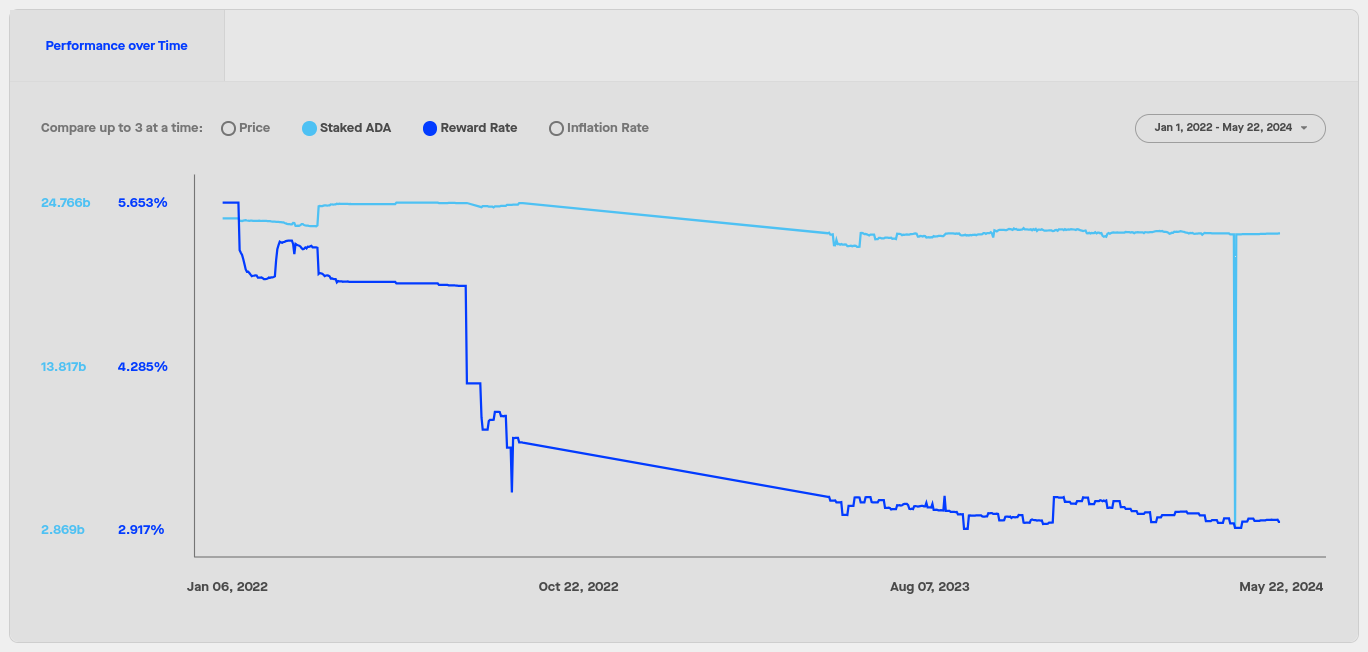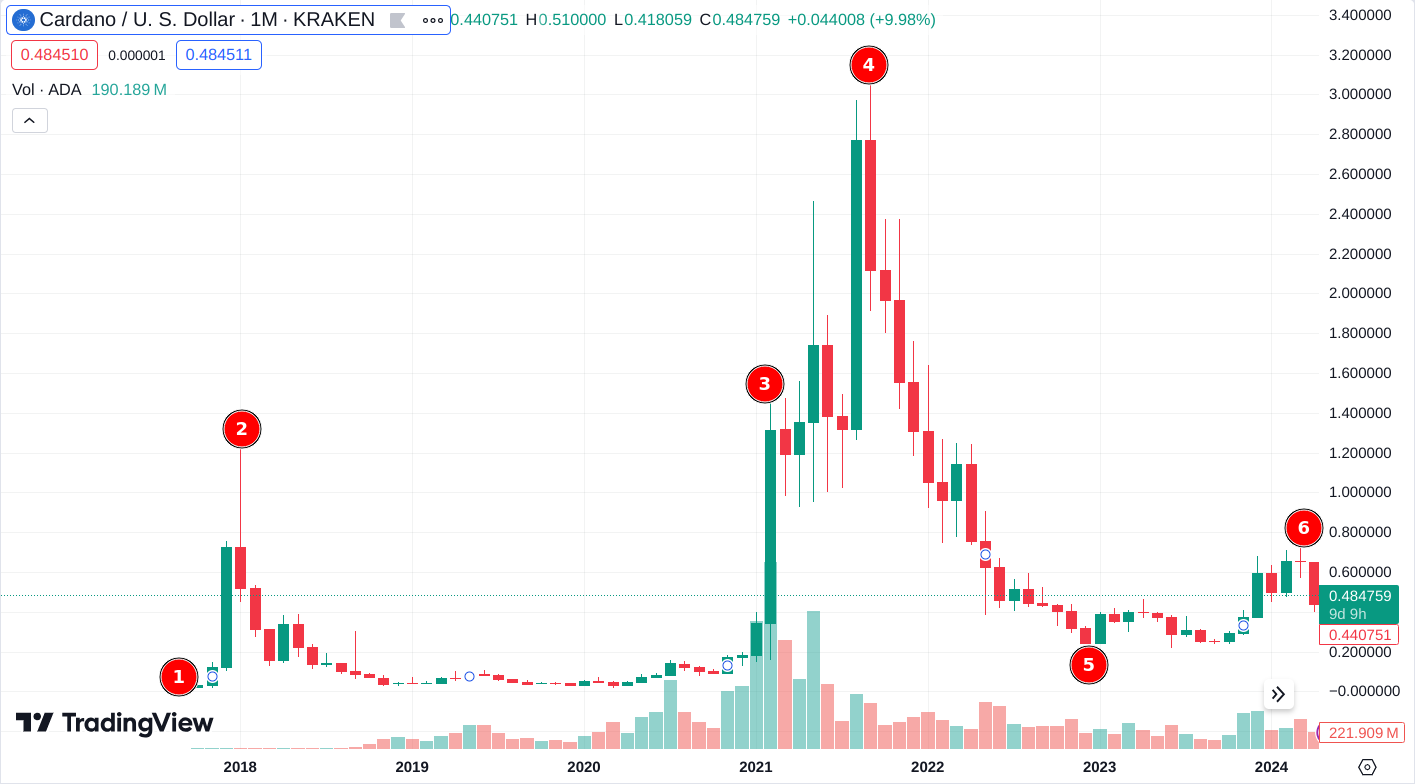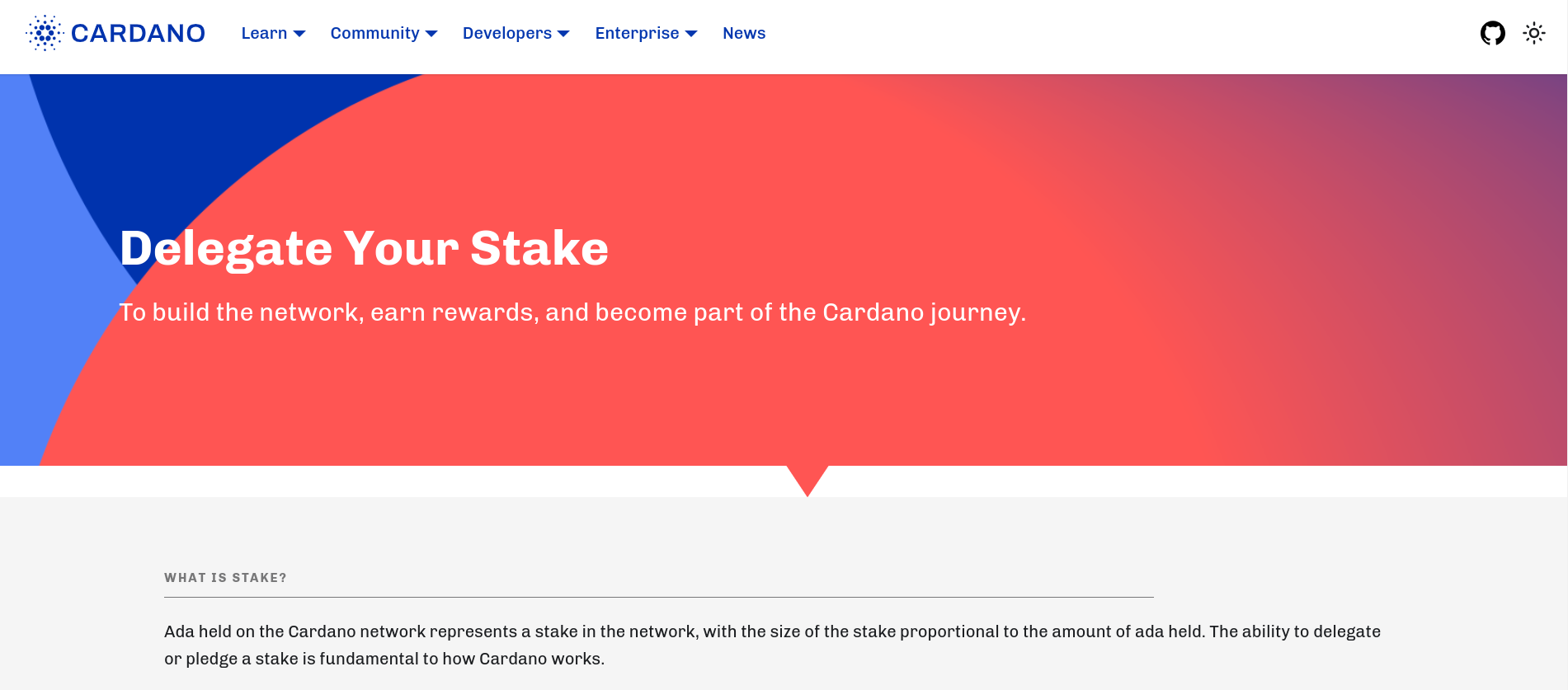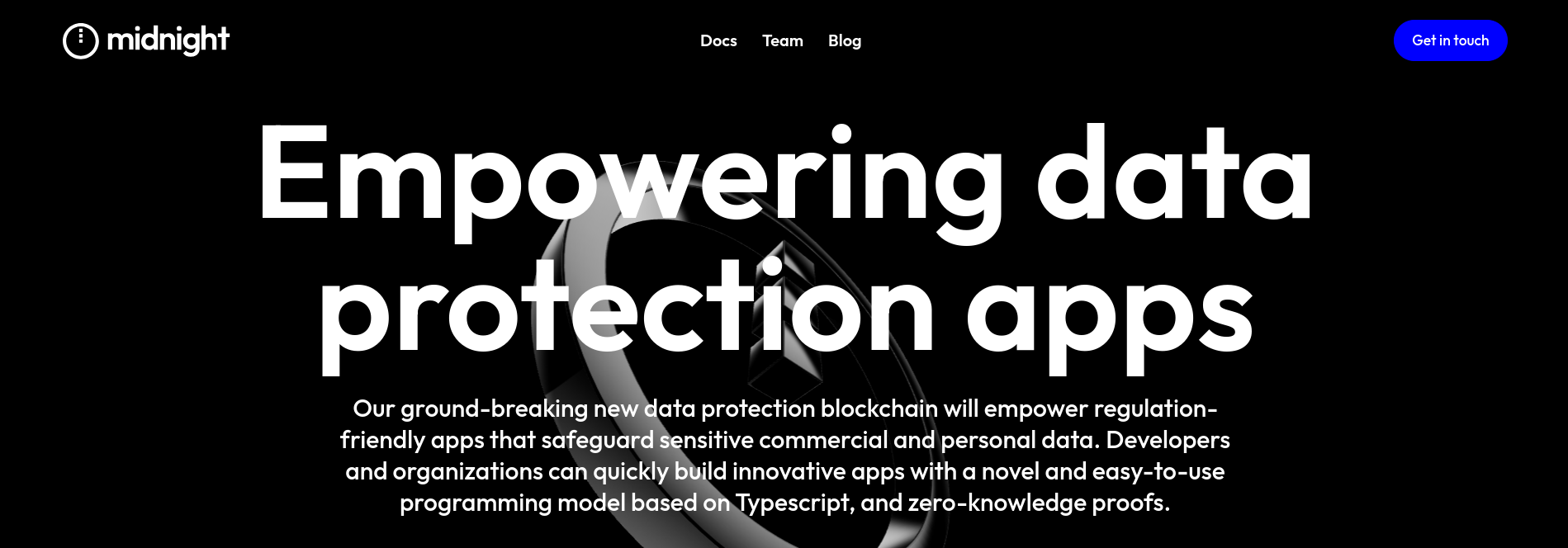Blockchain
Is Cardano a Good Investment in 2024?

Last updated:
May 24, 2024 06:18 EDT
| 11 min read
Cardano is known for its deliberate pace of development. Rather than rush to market with half-baked code, Cardano moves at its own speed, giving thoughtful consideration to the long-term goals based on five sequential eras (phases of development). The project boasts an extremely loyal following and attractive staking rewards, but is Cardano a good investment?
The project was founded in 2017 to address some of the shortcomings of Ethereum at the time, including scalability. At the helm, Charles Hoskinson, a co-founder of the Ethereum project, keeps the community updated and discusses the state of the chain and the industry through frequent fireside chats. In this guide, we’ll explore the history of Cardano (ADA) and look toward the future to see what lies ahead for ADA investors.

How Has Cardano Performed as an Investment?
Is ADA a good investment? To answer the question, let’s begin with Cardano’s performance relative to other cryptocurrencies. Many within the ADA community see Cardano as a long-term investment. If you’re looking for parabolic growth like you might see with the latest meme coins, you may not find that with ADA in the short term. Instead, a steady climb is more likely, albeit with a solid floor due to a loyal following and dependable staking rewards, currently about 3%.
ADA first traded at $0.02 following the initial distribution of tokens between 2015 and 2017. Within three months, ADA traded at $1.31. By the height of 2021’s crypto bull run, Cardano’s ADA token reached a price of $3.10, a 15400% increase. However, like other top projects in the crypto market, Cardano’s price fell dramatically throughout late 2021 and 2022 before beginning to recover in 2023. As of this writing, ADA trades at $0.48.
By comparison, other top-ten cryptocurrencies like Bitcoin (BTC) and Ethereum (ETH) have seen a stronger recovery from their bear-market lows. BTC has gone on to set new all-time highs following the Bitcoin halving and approval of several spot Bitcoin exchange-traded funds (ETFs) in the US. ETH has yet to recover fully, climbing to $3,700 from its lows but still short of its all-time high of $4,700.
During the downturn, ADA investors enjoyed staking yields of up to 5.6%, paid in ADA tokens to grow their positions. The amount of staked ADA has remained stable at more than 22 to 24 billion tokens in recent months, representing about 66% of the supply. By comparison, 25% of ETH is staked. These staking rewards, along with existing tokens, add to investor gains as ADA increases in value.

Cardano Price History Timeline
ADA’s trading price follows a similar pattern to other leading crypto projects that saw a spectacular rise in 2021, followed by a deep rut in 2022 before bottoming in 2023.

- 2017 – $0.02: ADA’s humble beginnings didn’t last long. The tail end of the 2017 bull market saw prices climb from $0.02 rapidly.
- 2018 – $1.31: By the beginning of 2018, ADA traded at $1.31. However, the bragging rights on gains wouldn’t last. ADA fell to its original price of $0.02 by 2019, remaining essentially flat until mid-2020.
- 2021 – $1.48: The 2021 crypto bull run sent Cardano much higher, reaching $1.50 briefly in February.
- 2021 – $3.10: After setting support at the previous all-time high of $1.31, ADA marched higher, reaching a new all-time high of $3.10 in September of 2021.
- 2023 – $0.22: After peaking at more than $3.00, ADA fell throughout the bear market, reaching a low of $0.22 in January of 2023 and retesting this level in September.
- 2024 – $0.48: Late 2023 and early 2024 marked a recovery for Cardano, nearly tripling ADA’s price from the lows before retracing to $0.48.
While ADA investors saw a massive selloff from the 2021 highs, staking was introduced in 2020, giving holders a dependable yield. As prices bottomed, yields increased relative to price, flirting with 6% at times.
Cardano Price Forecast
If you’re wondering, “Should I buy Cardano?” the following might help. Let’s see what may be ahead. Although some traders jokingly refer to ADA as a stablecoin, others predict that Cardano’s price going forward may surprise the naysayers. Our own detailed Cardano price prediction sees Cardano potentially reaching more than $2.60 by 2025.
Cardano Price Forecast 2024
Cardano was among more than a dozen cryptocurrencies named as securities in a June 2023 Securities and Exchange Commission (SEC) lawsuit against Coinbase. While the court case ensues, several of the named tokens are not available for trading on some exchanges. That could limit the short-term upside for ADA. Our Cardano ADA price prediction puts the trading range between $0.40 and $1.03, with an average price of $0.60.
Cardano Price Forecast 2025
Moving beyond 2024, pricing predictions for ADA look more promising. The crypto bull market is expected to be in full swing, aided by the Bitcoin halving that occurred in 2024 and Bitcoin ETFs bringing a wider audience to digital assets. Our Cardano price prediction sets the expected trading range between $0.80 and $2.42 in 2025, with an average price of $1.20. Compared to today’s price of $0.48, the high end of the range points to a nearly 5x return.
Cardano Price Forecast 2030
Is Cardano a good long-term investment? Many argue that ADA is a long-term play, so let’s look a bit further into the future to see what may be possible. By 2030, we’ll have the 5th Bitcoin halving behind us, pushing markets higher with each four-year halving. ADA and other tokens are expected to benefit. Our longer-term ADA Cardano price prediction puts Cardano’s trading range for 2030 between $3.80 and 4.50, potentially a 10x return from today’s prices.
Bitcoin and bull markets aside, by 2030, Cardano may have achieved many of the project’s goals, including that of becoming an “Internet of Blockchains,” a way to connect the disparate corners of the crypto world and provide an alternative finance platform for underserved communities and nations.
Is Cardano a Good Long-Term Investment?
Cardano’s deliberate development schedule speaks to the project’s goal of building a lasting Cardano ecosystem with a powerful protocol that’s both flexible and durable. The project is led by Charles Hoskinson, a cofounder of the Ethereum blockchain, and actively seeks partnerships with businesses, institutions, and governments.

Like Ethereum, Cardano supports smart contracts, making it a fertile ground for builders and developers. Unlike Ethereum, Cardano offers native liquid staking, making it easy for holders to support Cardano’s proof-of-stake consensus mechanism while still maintaining access to funds when needed.

Additionally, Cardano does not use slashing, which can put staked tokens at risk. This makes Cardano an attractive option for safety-conscious investors who want to earn crypto passive income.
Is Cardano worth buying? Let’s look at some of the factors that could make ADA a profitable long-term investment.
Strong and Experienced Leadership
Charles Hoskinson is the face of Cardano, having founded the company that developed the blockchain, Input Output Hong Kong, which has since rebranded to Input Output Global.
Charles has a pedigreed history in the crypto space, having cofounded the Ethereum project, now the largest smart contract platform in the world. Charles is known for his frank opinions and straight talk on all things blockchain and is well-respected for his vision for the Cardano project.

Among Charles Hoskinson’s other accomplishments in the crypto space, Charles was the founding chairman of the Bitcoin Foundation’s education committee and founded the Cryptocurrency Research Group. Charles describes Cardano, his current project, as a third-generation cryptocurrency, with Bitcoin being a first-generation and Ethereum being a second-generation project.
Charles describes the concepts behind Cardano’s third-generation blockchain in a detailed whiteboard video, focusing on how Cardano achieves scalability, interoperability, and sustainability. While an older video, it’s worth a watch to understand the long-range mindset behind the project.
Expanding Partnerships and Use Cases
Cardano’s use cases are more than theoretical. Cardano has already partnered with governments, businesses, and institutions.
While chains like Ethereum and Solana focus on decentralized finance applications (and a fair amount of meme coin trading), Cardano is partnering with governments and businesses to provide blockchain solutions that improve everyday life, particularly in developing countries. However, Cardano’s support for smart contracts means that the Cardano blockchain can also host the types of decentralized applications that made Ethereum and Solana so popular.
Energy-Efficient PoS Algorithm
Cardano uses an energy-efficient proof-of-stake (PoS) consensus mechanism to secure transactions on the blockchain. Cardano describes the Ouroboros protocol as “provably secure,” comparing the security of the Cardano blockchain to that of Bitcoin’s highly secure blockchain. A 2019 whitepaper details the security of the protocol. However, because it doesn’t use mining, Ouroboros is up to four million times more energy efficient than Bitcoin’s mining-based security.
Ouroboros used slot leaders, validators that maintain blocks for transactions, much like a miner does in the Bitcoin protocol, but without the computational power required by Bitcoin mining. These slot leaders can also maintain multiple blocks on multiple chains, making Cardano much more efficient and scalable compared to most popular blockchains.
What Does The Future Hold For Cardano?
Cardano’s multi-layer structure makes it extremely flexible, allowing a multitude of applications ranging from blockchain-based data storage to DeFi applications. Promising new initiatives like Cardano’s Midnight blockchain can address privacy concerns while maintaining blockchain-based accountability.

Cardano separates the Cardano Settlement Layer (CSL) from the Cardano Computation Layer (CCL), allowing fast settlements and validation while also enabling support for multiple blockchains. Governments, institutions, or businesses can build their own computation layer while securing data and transactions with Cardano’s CSL. Midnight is an example of this partner-chain implementation, securing transitions through Cardano while maintaining data privacy.
Cardano separates its roadmap using eras, each of which brings new functionality or efficiencies to the blockchain. In the current and final named era, Voltaire introduces governance, further decentralizing the Cardano network. What began as a blockchain fostered by a well-funded corporation will become a blockchain governed by and for a worldwide community.

Cardano’s roadmap also includes support for sidechains, a strategy to offload computational work to improve throughput. With enhanced scalability, availability of data privacy through Midnight, support for partner chains, and robust smart contracts, it’s difficult to imagine a blockchain-based application in which Cardano wouldn’t excel.
However, support for the blockchain is still growing. For example, Cardano doesn’t currently have a major fiat-backed stablecoin like USDC or USDT. The absence of a well-known stablecoin hampers DeFi development on the chain. In the interim, USDM, a fledgling fiat-based stablecoin, and DJED, an algorithmic stablecoin, are on the network, but notably, both coins have lost their peg from the US dollar under stress.
What Experts Say on Whether You Should Buy Cardano
Cardano price predictions from industry thought leaders range from $2 to $3.50. Some more optimistic predictions reach as high as $5 or even $10 on a longer timeline. However, you’ll also find some ADA bears.
- Coinpedia sees ADA as high as $10.32 by 2030.
- Changelly foresees ADA reaching $6.50 by 2030.
- Matiu Rudolph, COO of Layer One X, predicts $10 ADA by 2030.
- Omnia Markets founder Mitseh Shah sees an ADA price of $2.75 by 2025
However, the community itself sends mixed signals. When polled, Binance users predicted the price of ADA would only reach $0.64 by 2030.
Bear in mind that Cardano’s ADA token has a maximum supply of 45 billion ADA, 37 billion of which are in circulation. More tokens will be available as time passes. It’s essential to consider the fully diluted market cap when making your investment decision. A larger supply could dampen Cardano’s price action.
Conclusion – Is ADA a Good Investment?
ADA likely fits the investment goals of someone who prefers slow but reliable price appreciation. Based on past performance, ADA may not perform like Solana or the latest meme coin that fluctuates wildly due to crypto market trends. However, many see Cardano as a more robust platform that will survive and thrive in the long term. In the interim, ADA holders can stake their tokens to earn a yield, building their Cardano stack for a market that rewards patience.
FAQs
Can Cardano hit $10?
Some predictions see Cardano reaching as high as $10. However, these higher goals extend to a longer time horizon. If you’re able to wait until 2030, it’s possible for ADA to reach $10 or higher.
How high can Cardano realistically go?
Some experts predict prices as high as $10 for Cardano’s ADA token. Significantly higher prices for Cardano likely require more news about partnerships or new implementations. For example, the addition of a major stablecoin like USDT or USDC could cause Cardano usage to skyrocket, driving the price of ADA as well.
How much will 1 Cardano be worth in 2030?
Price predictions for Cardano by 2030 range from $2 up to more than $10. However, holders of the ADA token can stake their tokens to earn a yield. This means 1 ADA will generate additional ADA tokens, increasing your return over a longer time period.
What makes Cardano a better investment than other cryptocurrencies?
Cardano’s scalability makes it a better solution than Ethereum for many applications. Additionally, the protocol’s Ouroborus consensus mechanism makes it 4 million times more energy efficient than Bitcoin while offering comparable transaction security.
References
About the Author
Eric Huffman’s background includes a decade plus in business management as well as personal finance industry experience in insurance and lending. A strong understanding of consumer finance combined with a consumer advocate stance brought Eric to the crypto industry, where he writes articles and guides aimed at making crypto easier to understand.
About Cryptonews
At Cryptonews, we aim to provide a comprehensive and objective perspective on the cryptocurrency market, empowering our readers to make informed decisions in this ever-evolving landscape.
Our editorial team, comprised of more than 20 professionals in the crypto space, works diligently to uphold the highest standards of journalism and ethics. We follow strict editorial guidelines to ensure the integrity and credibility of our content.
Whether you’re seeking breaking news, expert opinions, educational resources, or market insights, Cryptonews.com is your go-to destination for all things crypto since 2017.
Blockchain
Bitcoin (BTC) Price Crashes as Donald Trump’s Win Odds Dip

Markets received nominally good news on Thursday morning, with the US ISM manufacturing PMI for July falling much more than economists expected, sending interest rates to multi-month lows across the board. Additionally, initial jobless claims in the US jumped to their highest level in about a year. Taken together, the data adds to the sentiment that the US is on the verge of a cycle of monetary easing by the Federal Reserve, which is typically seen as bullish for risk assets, including bitcoin.
Blockchain
Terra Blockchain Reboots After Reentry Attack Leads to $4M Exploit

Please note that our Privacy Policy, terms of use, cookiesAND do not sell my personal information has been updated.
CoinDesk is a awarded press agency that deals with the cryptocurrency sector. Its journalists respect a rigorous set of editorial policiesIn November 2023, CoinDesk has been acquired from the Bullish group, owner of Bullisha regulated digital asset exchange. Bullish Group is majority owned by Block.one; both companies have interests in a variety of blockchain and digital asset businesses and significant digital asset holdings, including bitcoin. CoinDesk operates as an independent subsidiary with an editorial board to protect journalistic independence. CoinDesk employees, including journalists, are eligible to receive options in the Bullish group as part of their compensation.
Blockchain
$6.8M Stolen, ASTRO Collapses 60%

In the latest news in the blockchain industry, there has been a turn of events that has severely affected Terra and its users and investors, with the company losing $6.8 million. The attack, which exploited a reentry vulnerability in the network’s IBC hooks, raises questions about the security measures of the once celebrated blockchain protocol.
A web3 security company, Cyvers Alerts reported that the exploit occurred on July 31st and caused the company to lose 60 million ASTRO, 3.5 million USDC500,000 USDTand 2. 7 BitcoinThe flaw was discovered in April and allows cybercriminals to make payments non-stop by withdrawing money from the network.
Earth’s response
Subsequently, to the hack employed on the Terra blockchain, its official X platform declared the Suspension network operations for a few hours to apply the emergency measure. Finally in its sendTerra’s official account agreed, sharing that its operations are back online: the core transactions that make up the platform are now possible again.
However, the overall value of the various assets lost in the event was unclear.
Market Impact: ASTRO Crashes!
The hack had an immediate impact on the price of ASTRO, which dropped nearly 60% to $0.0206 following the network shutdown. This sharp decline highlights the vulnerability of token prices to security breaches and the resulting market volatility.
This incident is not the first time Terra has faced serious challenges. Earlier this year, the blockchain encountered significant problems that called into question its long-term viability. These repeated incidents underscore the need for stronger security measures to protect users’ assets and maintain trust in the network.
The recent Terra hack serves as a stark reminder of the ongoing security challenges in the blockchain space. As the platform works to regain stability, the broader crypto community will be watching closely.
Read also: Record Cryptocurrency Theft: Over $1 Billion Stolen in 2024
This is a major setback for Terra. How do you think this will impact the blockchain industry?
Blockchain
Luxembourg proposes updates to blockchain laws | Insights and resources

On July 24, 2024, the Ministry of Finance proposed Blockchain Bill IVwhich will provide greater flexibility and legal certainty for issuers using Distributed Ledger Technology (DLT). The bill will update three of Luxembourg’s financial laws, the Law of 6 April 2013 on dematerialised securitiesTHE Law of 5 April 1993 on the financial sector and the Law of 23 December 1998 establishing a financial sector supervisory commissionThis bill includes the additional option of a supervisory agent role and the inclusion of equity securities in dematerialized form.
DLT and Luxembourg
DLT is increasingly used in the financial and fund management sector in Luxembourg, offering numerous benefits and transforming various aspects of the industry.
Here are some examples:
- Digital Bonds: Luxembourg has seen multiple digital bond issuances via DLT. For example, the European Investment Bank has issued bonds that are registered, transferred and stored via DLT processes. These bonds are governed by Luxembourg law and registered on proprietary DLT platforms.
- Fund Administration: DLT can streamline fund administration processes, offering new opportunities and efficiencies for intermediaries, and can do the following:
- Automate capital calls and distributions using smart contracts,
- Simplify audits and ensure reporting accuracy through transparent and immutable transaction records.
- Warranty Management: Luxembourg-based DLT platforms allow clients to swap ownership of baskets of securities between different collateral pools at precise times.
- Tokenization: DLT is used to tokenize various assets, including real estate and luxury goods, by representing them in a tokenized and fractionalized format on the blockchain. This process can improve the liquidity and accessibility of traditionally illiquid assets.
- Tokenization of investment funds: DLT is being explored for the tokenization of investment funds, which can streamline the supply chain, reduce costs, and enable faster transactions. DLT can automate various elements of the supply chain, reducing the need for reconciliations between entities such as custodians, administrators, and investment managers.
- Issuance, settlement and payment platforms:Market participants are developing trusted networks using DLT technology to serve as a single source of shared truth among participants in financial instrument investment ecosystems.
- Legal framework: Luxembourg has adapted its legal framework to accommodate DLT, recognising the validity and enforceability of DLT-based financial instruments. This includes the following:
- Allow the use of DLT for the issuance of dematerialized securities,
- Recognize DLT for the circulation of securities,
- Enabling financial collateral arrangements on DLT financial instruments.
- Regulatory compliance: DLT can improve transparency in fund share ownership and regulatory compliance, providing fund managers with new opportunities for liquidity management and operational efficiency.
- Financial inclusion: By leveraging DLT, Luxembourg aims to promote greater financial inclusion and participation, potentially creating a more diverse and resilient financial system.
- Governance and ethics:The implementation of DLT can promote higher standards of governance and ethics, contributing to a more sustainable and responsible financial sector.
Luxembourg’s approach to DLT in finance and fund management is characterised by a principle of technology neutrality, recognising that innovative processes and technologies can contribute to improving financial services. This is exemplified by its commitment to creating a compatible legal and regulatory framework.
Short story
Luxembourg has already enacted three major blockchain-related laws, often referred to as Blockchain I, II and III.
Blockchain Law I (2019): This law, passed on March 1, 2019, was one of the first in the EU to recognize blockchain as equivalent to traditional transactions. It allowed the use of DLT for account registration, transfer, and materialization of securities.
Blockchain Law II (2021): Enacted on 22 January 2021, this law strengthened the Luxembourg legal framework on dematerialised securities. It recognised the possibility of using secure electronic registration mechanisms to issue such securities and expanded access for all credit institutions and investment firms.
Blockchain Act III (2023): Also known as Bill 8055, this is the most recent law in the blockchain field and was passed on March 14, 2023. This law has integrated the Luxembourg DLT framework in the following way:
- Update of the Act of 5 August 2005 on provisions relating to financial collateral to enable the use of electronic DLT as collateral on financial instruments registered in securities accounts,
- Implementation of EU Regulation 2022/858 on a pilot scheme for DLT-based market infrastructures (DLT Pilot Regulation),
- Redefining the notion of financial instruments in Law of 5 April 1993 on the financial sector and the Law of 30 May 2018 on financial instruments markets to align with the corresponding European regulations, including MiFID.
The Blockchain III Act strengthened the collateral rules for digital assets and aimed to increase legal certainty by allowing securities accounts on DLT to be pledged, while maintaining the efficient system of the 2005 Act on Financial Collateral Arrangements.
With the Blockchain IV bill, Luxembourg will build on the foundations laid by previous Blockchain laws and aims to consolidate Luxembourg’s position as a leading hub for financial innovation in Europe.
Blockchain Bill IV
The key provisions of the Blockchain IV bill include the following:
- Expanded scope: The bill expands the Luxembourg DLT legal framework to include equity securities in addition to debt securities. This expansion will allow the fund industry and transfer agents to use DLT to manage registers of shares and units, as well as to process fund shares.
- New role of the control agent: The bill introduces the role of a control agent as an alternative to the central account custodian for the issuance of dematerialised securities via DLT. This control agent can be an EU investment firm or a credit institution chosen by the issuer. This new role does not replace the current central account custodian, but, like all other roles, it must be notified to the Commission de Surveillance du Secteur Financier (CSSF), which is designated as the competent supervisory authority. The notification must be submitted two months after the control agent starts its activities.
- Responsibilities of the control agent: The control agent will manage the securities issuance account, verify the consistency between the securities issued and those registered on the DLT network, and supervise the chain of custody of the securities at the account holder and investor level.
- Simplified payment processesThe bill allows issuers to meet payment obligations under securities (such as interest, dividends or repayments) as soon as they have paid the relevant amounts to the paying agent, settlement agent or central account custodian.
- Simplified issuance and reconciliationThe bill simplifies the process of issuing, holding and reconciling dematerialized securities through DLT, eliminating the need for a central custodian to have a second level of custody and allowing securities to be credited directly to the accounts of investors or their delegates.
- Smart Contract Integration:The new processes can be executed using smart contracts with the assistance of the control agent, potentially increasing efficiency and reducing intermediation.
These changes are expected to bring several benefits to the Luxembourg financial sector, including:
- Fund Operations: Greater efficiency and reduced costs by leveraging DLT for the issuance and transfer of fund shares.
- Financial transactions: Greater transparency and security.
- Transparency of the regulatory environment: Increased attractiveness and competitiveness of the Luxembourg financial centre through greater legal clarity and flexibility for issuers and investors using DLT.
- Smart Contracts: Potential for automation of contractual terms, reduction of intermediaries and improvement of transaction traceability through smart contracts.
Blockchain Bill IV is part of Luxembourg’s ongoing strategy to develop a strong digital ecosystem as part of its economy and maintain its status as a leading hub for financial innovation. Luxembourg is positioning itself at the forefront of Europe’s growing digital financial landscape by constantly updating its regulatory framework.
Local regulations, such as Luxembourg law, complement European regulations by providing a more specific legal framework, adapted to local specificities. These local laws, together with European initiatives, aim to improve both the use and the security of projects involving new technologies. They help establish clear standards and promote consumer trust, while promoting innovation and ensuring better protection against potential risks associated with these emerging technologies. Check out our latest posts on these topics and, for more information on this law, blockchain technology and the tokenization mechanism, do not hesitate to contact us.
We are available to discuss any project related to digital finance, cryptocurrencies and disruptive technologies.
This informational piece, which may be considered advertising under the ethics rules of some jurisdictions, is provided with the understanding that it does not constitute the rendering of legal or other professional advice by Goodwin or its attorneys. Past results do not guarantee a similar outcome.
-

 Regulation12 months ago
Regulation12 months agoRipple CTO and Cardano founder clash over XRP’s regulatory challenges ⋆ ZyCrypto
-

 Regulation10 months ago
Regulation10 months agoNancy Pelosi Considers Supporting Republican Crypto Bill FIT21 – London Business News
-

 Videos11 months ago
Videos11 months agoCryptocurrency News: Bitcoin, ETH ETF, AI Crypto Rally, AKT, TON & MORE!!
-

 Regulation11 months ago
Regulation11 months agoBitcoin’s future is ‘bleak’ and ripe for regulation, says lead developer
-

 News8 months ago
News8 months agoAave Price Increases Following Whales Accumulation and V3.1 Launch
-

 Regulation8 months ago
Regulation8 months agoSouth Korea Imposes New ‘Monitoring’ Fees on Cryptocurrency Exchanges
-

 Regulation8 months ago
Regulation8 months agoA Blank Sheet for Cryptocurrencies: Kamala Harris’ Regulatory Opportunity
-

 Regulation8 months ago
Regulation8 months agoCryptocurrency Regulations in Slovenia 2024
-

 News11 months ago
News11 months agoThe trader earned $46 million with PEPE after reaching a new ATH
-

 Regulation10 months ago
Regulation10 months agoCrypto needs regulation to thrive: Tyler Cowen
-

 Blockchain11 months ago
Blockchain11 months agoSolana ranks the fastest blockchain in the world, surpassing Ethereum, Polygon ⋆ ZyCrypto
-

 Blockchain11 months ago
Blockchain11 months agoSolana Surpasses Ethereum and Polygon as the Fastest Blockchain ⋆ ZyCrypto






